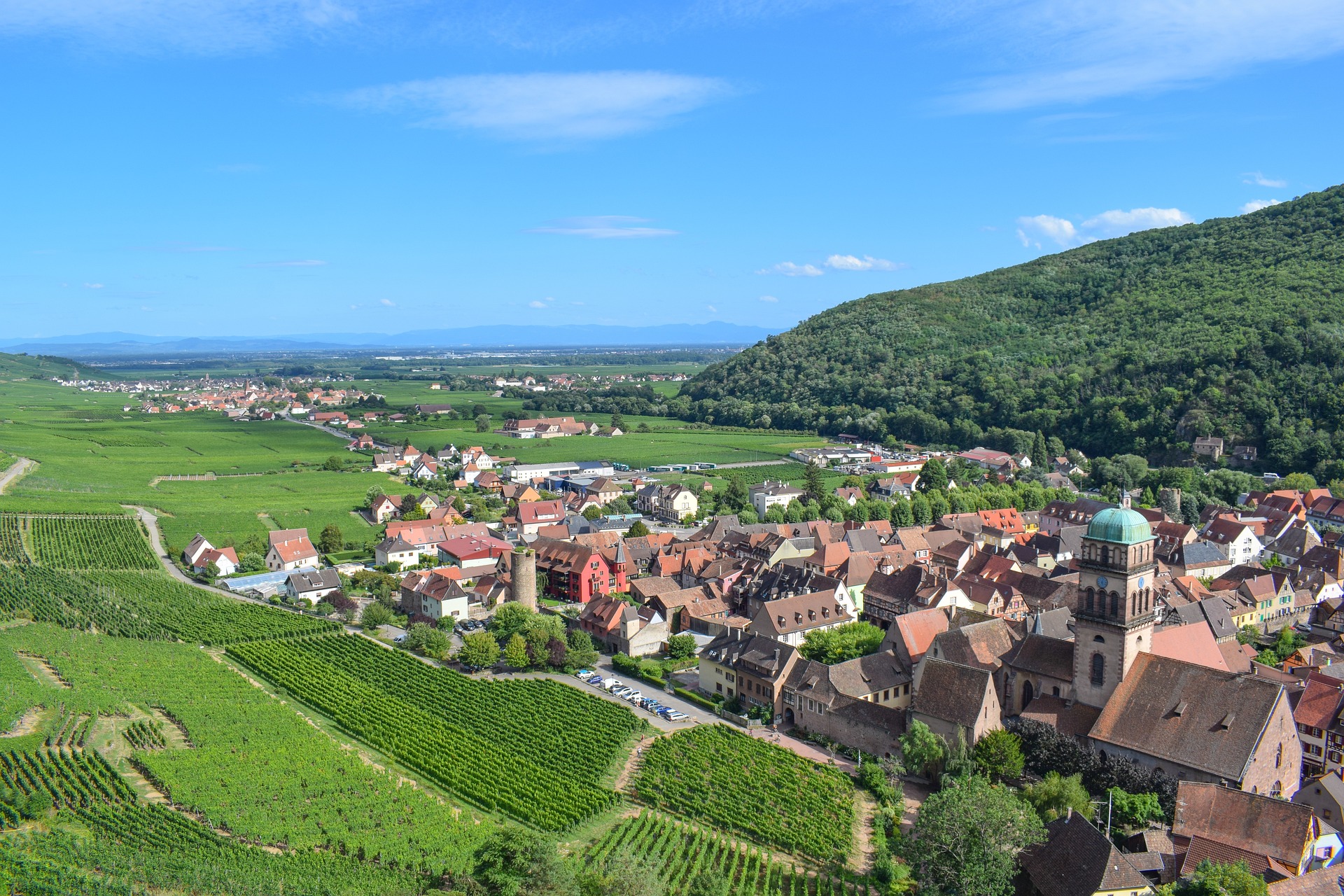This region inevitably conjures up images of storks and nectar squeezed from the generous mamelons bordering the Vosges mountains. But Alsace is above all a vast plain, the collapse trough of the Rhine created by the tearing apart of the earth’s crust in the Tertiary period. Covered with fertile alluvial deposits, the soil is humid to the point of becoming waterlogged in the vicinity of the river and its tributary the Ill: this is the “Ried” between Colmar and Strasbourg. This term derives from the Alemannic Rieth, meaning “reed”. It refers to an exceptional landscape of floodplain meadows and lush vegetation, part of which has been set aside as a nature reserve.
An excursion into the Ried takes us into an ancient world where the power of vegetation expresses itself freely. The alluvial forest seems untouched by man, even though he has exploited it for thousands of years. The combination of constant humidity and summer heat provides plants with the conditions for rapid, expansive growth: between the herbaceous plants that cover the ground in often imposing clumps and the tree tops, a veritable canopy comparable to that of tropical forests, there are dense bushes and countless shrubs stretching their vigorous trunks towards the light. A tangle of lianas falls from the trees. The flora is rich and varied.
In the heat of the alluvial forests

This is the domain of theangelica sylvestre, a robust mistress of the undergrowth, whose name is a guarantee of long-appreciated virtues. Its elegantly cut foliage is enough to make it stand out. But from late spring onwards, a thick, fleshy stem emerges, growing steadily and eventually bearing large, shaggy heads that beckon the walker from afar. The stem is often purple, an unusual color that also stains the base of the leaves. It’s not unusual for the flowers to take on a vinous hue that makes them stand out against the surrounding green. Chubby, radiating half-spheres, angelica’s umbels betray its membership of the Umbelliferae family, like carrots and parsley.
To meet its big sister, the archangelic angelica, higher in the celestial hierarchy as it is in size, we’d have to brave the frosts of northern Germany or Scandinavia, as it’s confined to northern Europe. We could also explore the “curé gardens” where it is grown, or explore the Poitevin marshes. In any case, both species have the same virtues, even if our native has a fiercer character than that of the sweet-scented archangelica.

A yellowish-white, pungent and bitter resin, rich in aromatic essence, emerges from the cut of an angelica stem. The whole plant, but especially the root, tones the body and aids digestion. It is said to be “carminative”, as it has the useful property of expelling from the intestine the gas produced by imperfectly absorbed food. A “natural” way to treat a cold is to dig up an angelica root in the woods, brush it carefully under running water and then regularly eat cut-up fragments. Improvement guaranteed! In the 19th century, physician Bodard was full of praise: ” …if this plant were a foreign plant, it would be as valuable to us as ginseng is to the Orientals, and it would sell for gold… “. It’s true that angelica, like the Asian panacea, has the ability to regenerate tired organisms. Annibal Camoux, who died in Marseille at the remarkable age of 121, attributed his exceptional longevity to his habit of chewing angelica root every morning.
The famous candied angelica stems come from the archangelica plant. Today’s commercial candied angelica stems are commonly made from tasteless, brightly-colored celeriac, and are of no interest whatsoever in terms of taste. Wild angelica is ideal for making your own real angelica stems, a concentrate of flavours and virtues. Stems should be harvested in early summer, when they are still tender to the touch. Instead of discarding the stem peelings and inflorescences, tie them in a cloth and plunge them into the basin where the strawberries or raspberries are cooking. The result is jam with a deliciously sylvan taste!
| Candied Angelica Stems – Select stems that are still very tender. – Peel them and cut into ten-centimeter sections. – Cook them in boiling water for half an hour, then drain. – Place the stems in a sugar syrup made with the same amount of sugar and water. – Bring to a rolling boil. After half an hour, pour into a bowl. – The next day, return the syrup to a saucepan and boil it again, then pour it over the stems in their terrine. – Repeat for three consecutive days. – Remove the stems from the terrine and dry on a wire rack. – Store in closed jars. – Use in cakes, of course, but also in muesli, fruit salads and chutneys. |
In the summer mugginess, forest paths are lined with wispy tufts perched on long, anorexic stalks: that’s how valerian stands out. Let’s take a closer look. The small, white-pink flowers, with their ambiguous, half-violet, half-feline fragrance, cluster in flattened inflorescences, or corymbs. Along the stem are pairs of narrow-segmented leaves bordered by a few rounded teeth.
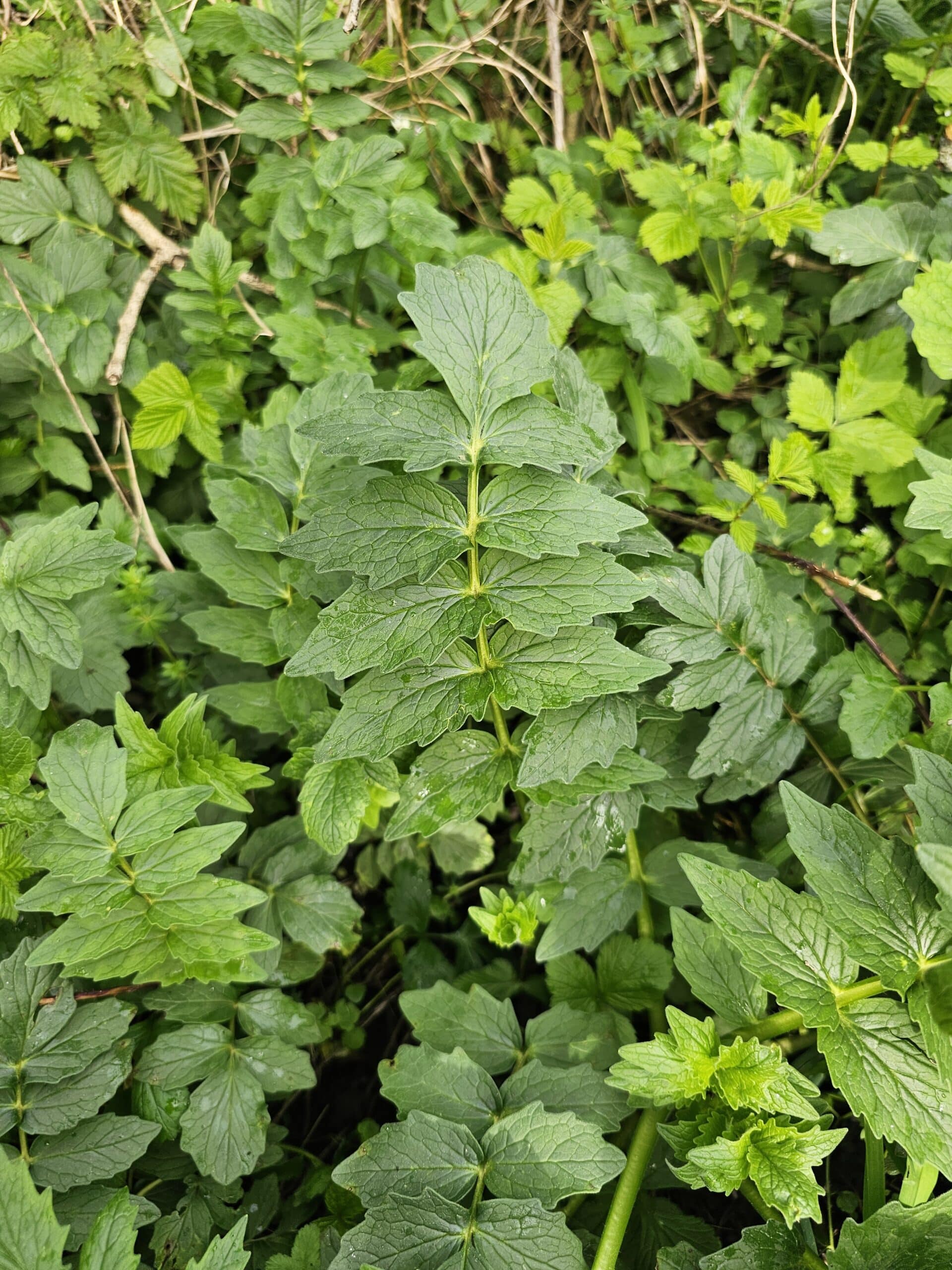
Valerian hides its treasures beneath the ground, in this case its thick, brown, fragrant roots. Do they give off a sweet perfume or an abominable stench? Everyone perceives the scent according to the twists and turns of their own olfactory history. For some, the underground parts of valerian are so characteristically cat-pee smelling that many pharmacists refuse to stock them in their dispensaries. Other noses don’t disdain their spicy exhalations… Indeed, this “catnip” excites and euphorizes our moustachioed companions.
Whether we like their fragrance or not, these roots possess virtues prized by all, and their contribution to the well-being of suffering humanity has given valerian its name, from the Latin valeo, “to be in good health”. Indeed, this very common plant promotes sleep and improves its quality, benefits that are particularly appreciated in our age of chronic stress. Taken in cures, valerian effectively helps to rebalance the nervous system, which has been battered by years of abuse… But its powers remain a mystery, as no one has been able to define a precise active principle that could be at the root of its undeniable effects. In such cases, phytotherapists speak of a “totum”, a set of substances whose activities are mutually reinforcing. This is often the case with herbal remedies, which explains their usual absence of side-effects, in contrast to synthetic drugs, whose effect derives from a single active principle.

In richly hued greenery, marshmarigold could go unnoticed. A trained eye, however, will effortlessly distinguish a plant with a rigid stem bearing long, slightly embossed, opposite leaves, with a shimmering spike of bright pink flowers at the top. It lives in colonies formed from the multiple offshoots of its long underground stems, which stretch and multiply in the rich, water-logged soil. These rhizomes serve as a food reserve in the off-season. You don’t have to dig deep to uncover the pearly swellings as big as your fingertips. In days gone by, people were quite fond of them, harvesting them for their pleasant flavor and nutritive virtues. But apparently no one ever thought of cultivating them.
Could it be that Asians are more inventive than us? At any rate, they’ve been cultivating a Far Eastern cousin of marsh marigold since time immemorial. Pailleux and Bois, who introduced it to Europe, named it “crosne” in 1882, after the Seine-et-Oise locality where their experimental garden was located. Its delicate, nutty tubers enjoyed great popularity in the “hip” circles of the time, before falling into unjustified oblivion like many other ancient vegetables. Fortunately, over the last fifteen years or so, gardening enthusiasts and the general public have rediscovered crosne, cardoon, parsnips, chervil tuberosa and other Jerusalem artichokes.
The deep, moist soils provide the perfect habitat for an astonishing thistle with no thorns, the cirse potager. Its large, rosette-shaped leaves are reminiscent of acanthus. Its tall stems bear groups of narrow flower heads with pale yellow, tube-shaped florets. This color distinguishes our thistle from its congeners, which prefer purple florets. The epithet “vegetable” alludes to the eminent eating qualities of this thistle, whose leaves are eaten as a vegetable. The youngest leaves are tender enough for salads, while the older ones have large veins that can be cooked like Swiss chard. Their flavor is close to that of its cousin, the artichoke. Both are rich in a particular sugar, inulin, which digestion transforms into fructose rather than glucose. For this reason, cirsis is recommended for diabetics.
| Alsatian-style cirse petioles – Select thick, fleshy petioles. – Tear and cut into 3 cm-long sections. – Peel and finely chop onions, and cut a piece of bacon into small cubes. – Fry the chopped onions and bacon for a few minutes. – Oil an ovenproof dish. Garnish with half the onions and bacon. Arrange the wax petioles on top and cover with the rest of the mixture. – Season with salt and pepper. – Dissolve some crème fraîche in a little white wine and pour the sauce over the entire surface of the dish. – Place in the oven and cook for one hour. Serve piping hot, straight from the oven, with a Riesling or Gewürztraminer. |
Forest bulrush thrives in woods with soggy soil. Its long, narrow, gutter-folded leaves intertwine to form dense green clumps. But beware, they are sharp. You’ll have to be delicate to tear them from their stumps to taste a few centimetres of the tender white base. Their flavor is as delicate as that of hearts of palm, and in our case, the plant will grow back without a care in the world.[1]. But don’t expect to make a salad out of them – they’re just choice morsels to whet your appetite.
Plants of Alsace: feet in the water
In some places, the water table rises and the water comes to the surface. This is not to the displeasure of beccabunga speedwell, a curious fat plant. It doesn’t come from Africa: its name is a distortion of the Germanic word Bachbunge, stream plant. Its plump, round, reddish stems bear thick, opposite leaves and long clusters of blue flowers typical of all veronicas: four unequal petals fused together and only two stamens. With a little imagination, the Veronica flower reproduces the sacred imprint of Christ’s face that St. Veronica wiped with a towel during the ascent to Calvary… The Greek Veronicon means “true image”.
Its other, less poetic name is “horse cress”. Like the famous watercress, beccabunga grows in watercourses and can also be eaten. But its bitterness is notorious and its flavor a little bitter… Just right for horses? Or perhaps it’s a quirk of Shakespeare’s language, in which coarse is phonetically close to horse. So we’ve slipped from coarse radish to horseradish to designate the pungent horseradish, castigating the unfortunate vegetable with a taste too strong for the refined palate of “honest people”. So let’s leave the latter to their lettuces, and not neglect to pick beccabunga stems, leaves and flowers to spice up our salads.
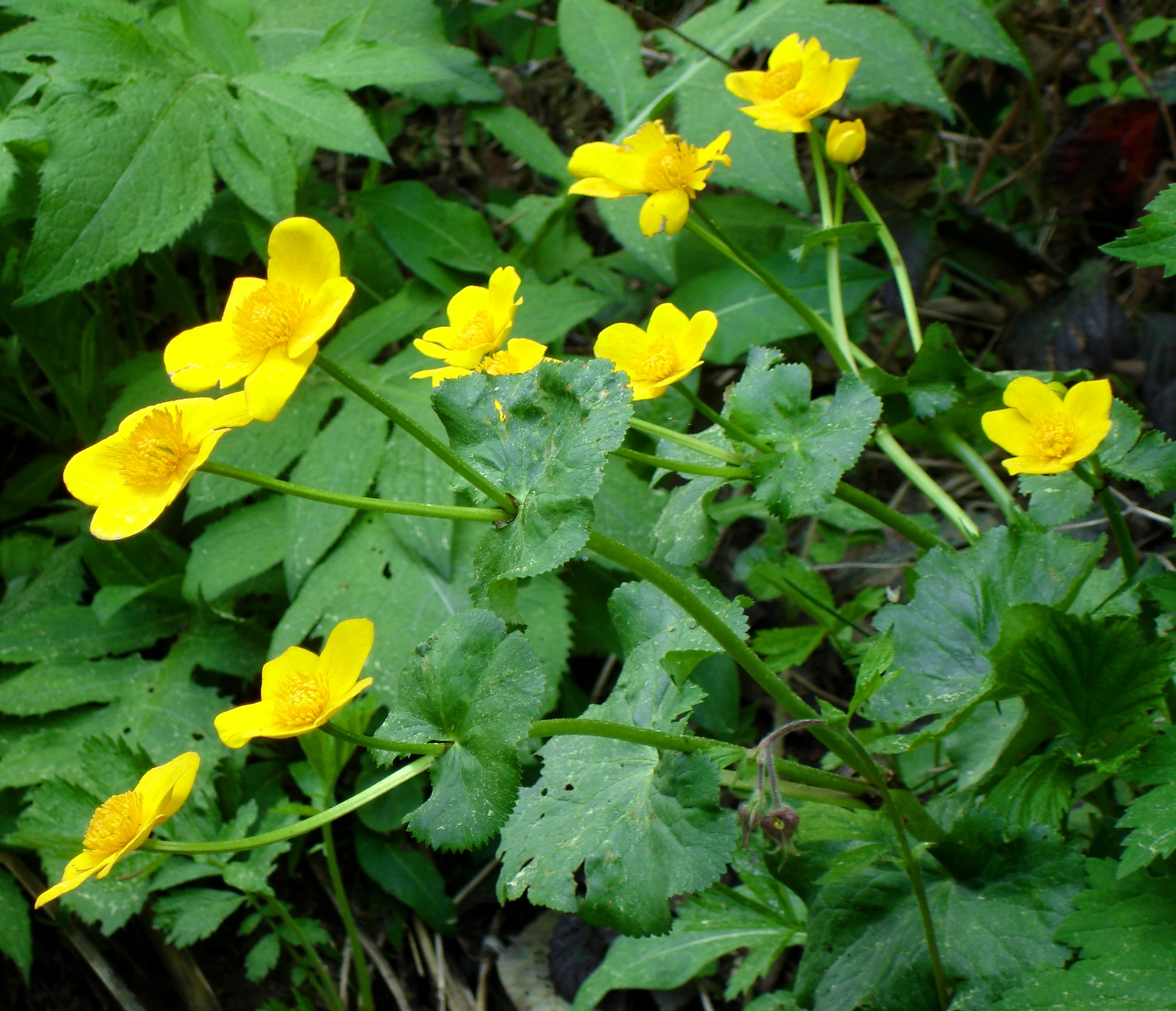
In spring, the superb golden-yellow flowers of poplars, set against the dark green of their rounded leaves, brighten up the austere landscape. They are sometimes called “water marigolds” by analogy with those that adorn our gardens. But they are in fact close relatives of ranunculus, with which they share a relative toxicity due to a pungent substance, protoanemonin: chewing a leaf will burn your mouth. This hasn’t stopped the flower buds from being preserved in vinegar. These wild capers are traditionally found deep in the bayous of the southern United States, where our plant happily wades.
The stems of bittersweet climb up the vegetation along the water’s edge. The leaves of this elegant liana are often divided into three segments, the two at the base forming like auricles and the upper one much larger. From their axils hang star-shaped clusters of flowers with five acute, slightly inverted, violet lobes, each with two green spots at the base, against which the yellow of the stamens stands out. These turn into elongated berries, first green, then glossy red when ripe.
The stems, with their sweet wood and bitter bark, are used as a depurative and diuretic. But the plant is toxic, especially the berries. Ingestion causes digestive, nervous, respiratory and cardiac disorders. They are rich in saponins and their seeds contain alkaloids similar to belladonna’s atropine.
By lakes and ponds
The aquatic environment requires plants to adapt to living constantly with their feet in the water. On the other hand, they are hardly subject to the effects of climate change that affect their terrestrial counterparts. In particular, drought is unknown to them. This is why lake-dwelling plants can be found almost everywhere on the planet. And so it is with the reed: in Alsace, as everywhere else in France and throughout the northern hemisphere from Africa to Siberia, from Mexico to China, ponds are lined with this giant grass. A real success story!
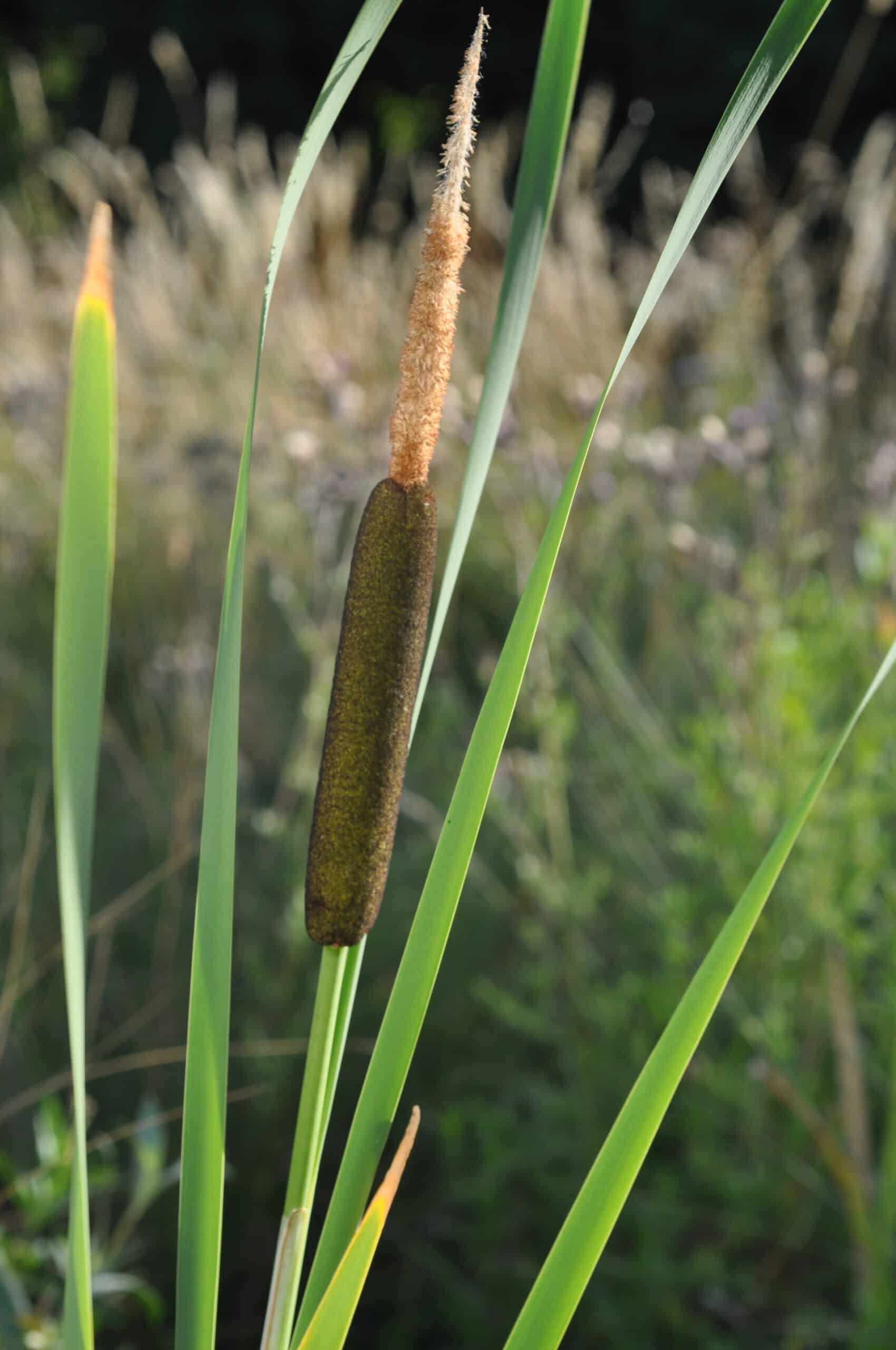
For the ancient Greeks, it was the reed that gave man music. Syrinx, a water nymph pursued by the lustful ardors of the god Pan, implored her father, the river-god Ladon, to turn her into a reed. Pan, displeased, plucked the hollow stems, which he assembled in different lengths to form the flute that bears his name. Our plant also has more prosaic applications. Its tender young stems, with their sweet licorice flavor, were once dried, ground and mixed with wheat flour to make cakes.
The reed is often confused with another equally ubiquitous waterside plant, the cattail. But as its name suggests, the latter has an elongated mass at the top of its stems, instead of the reed’s elegant plumes. In winter, these large brown cigars burst into life, releasing a multitude of seeds with a fluffy parachute that carries them across continents and seas.
The cattail could be nicknamed the “larder of the marshes”. Its young shoots and leaf bases are tender and crisp, with the fine flavor of hearts of palm. Perched at the top of the stem, the spike of male flowers spreads a profusion of golden pollen in early summer, which is easy to collect in the palm of your hand. Mixed with flour, it can be used to make surprisingly colorful pancakes or breads, rich in all the minerals contained in the fertilizing dust so generously generated by the plant. Female flower cobs, the future “cigars”, can be boiled and eaten like fresh corn with a little butter and salt. They are located just below the representatives of the opposite sex.

Discover our online course designed by François Couplan, an internationally recognized expert in ethnobotany with over 50 years’ experience. With 30 modules, 120 courses and high-quality theoretical instruction complemented by field courses, this unique three-year course will enable you to become a professional in the uses of plants. Accessible to all, it explores in depth the relationship between man and plants, opening up exciting professional opportunities. Join us to deepen your knowledge, explore the plant world and develop a rewarding relationship with nature.
A marvellous club! A complete survival kit, it can save the life of anyone lost in the wild. Its criss-crossing rhizomes in the mud, never far from the water’s surface, are bursting with an absolutely pure starch that could form the basis of a person’s diet for months. Of course, a few wild plants would be needed to supplement the supply of proteins, vitamins and minerals. But it’s starch that drives our organic engines, and the starch found in the underground stems of the cudgel is of the highest quality! Simply chew the pleasant-tasting underground stem. To extract the starch, North American Indians crushed the rhizomes and muddled them in water. After filtering, the whitish liquid was left to settle and the starch settled to the bottom. All that remained was to carefully drain off the supernatant water, dry the starch and then grind it into flour. Bonus: the long rhizome fibers released in the process can be used to make strong ropes. And the long, spongy leaves, criss-crossed by vessels that bring air to the roots to prevent asphyxiation, are woven into convenient mats.
It’s not unusual for a plant to be both beautiful and dangerous… Such is the case, on the banks of ponds, of theyellow iris. also says “yellow iris” or “marsh iris”. Its large clumps of leathery, elongated, slightly arching leaves, acute at the top, are highly decorative in themselves. But the plant becomes superb when its robust stem is adorned with large yellow flowers. Their structure is unique in the plant world: three large, downward-facing outer divisions and three small, upright inner divisions, between which are the broad, petal-like stigmas. Stylized, it is the fleur de lys of the kings of France. Clovis is said to have chosen this symbol in memory of the battle of Vouillé against the Visigoths in 507. During the battle, he wanted to cross the Vienne river to catch his enemies from the rear. In a place where irises grew in abundance, a ford was found which the Frankish troops were able to cross. And so they were victorious.
The thick underground stem of the marsh iris is very pungent. It burns the skin and would make anyone who tasted it vomit, even causing gastroenteritis. In other species, however, the rhizome is mild. In Asia, certain irises are cultivated for their edible rhizomes, which can be roasted or boiled. The rhizome of the Florence iris is used in perfumery for the sweet violet scent it acquires when dried. The ancients used to perfume their oil to anoint their bodies and eliminate odors: iris was thus the very first deodorant.
Iris was the servant of Zeus and Hera. Hera transformed her into a rainbow when she became Zephyr’s mistress and lost her virginity. She then became the messenger of the gods. The souls of mortals reached eternal rest by following the path formed by the rainbow, whose shimmering colors are found in some irises.
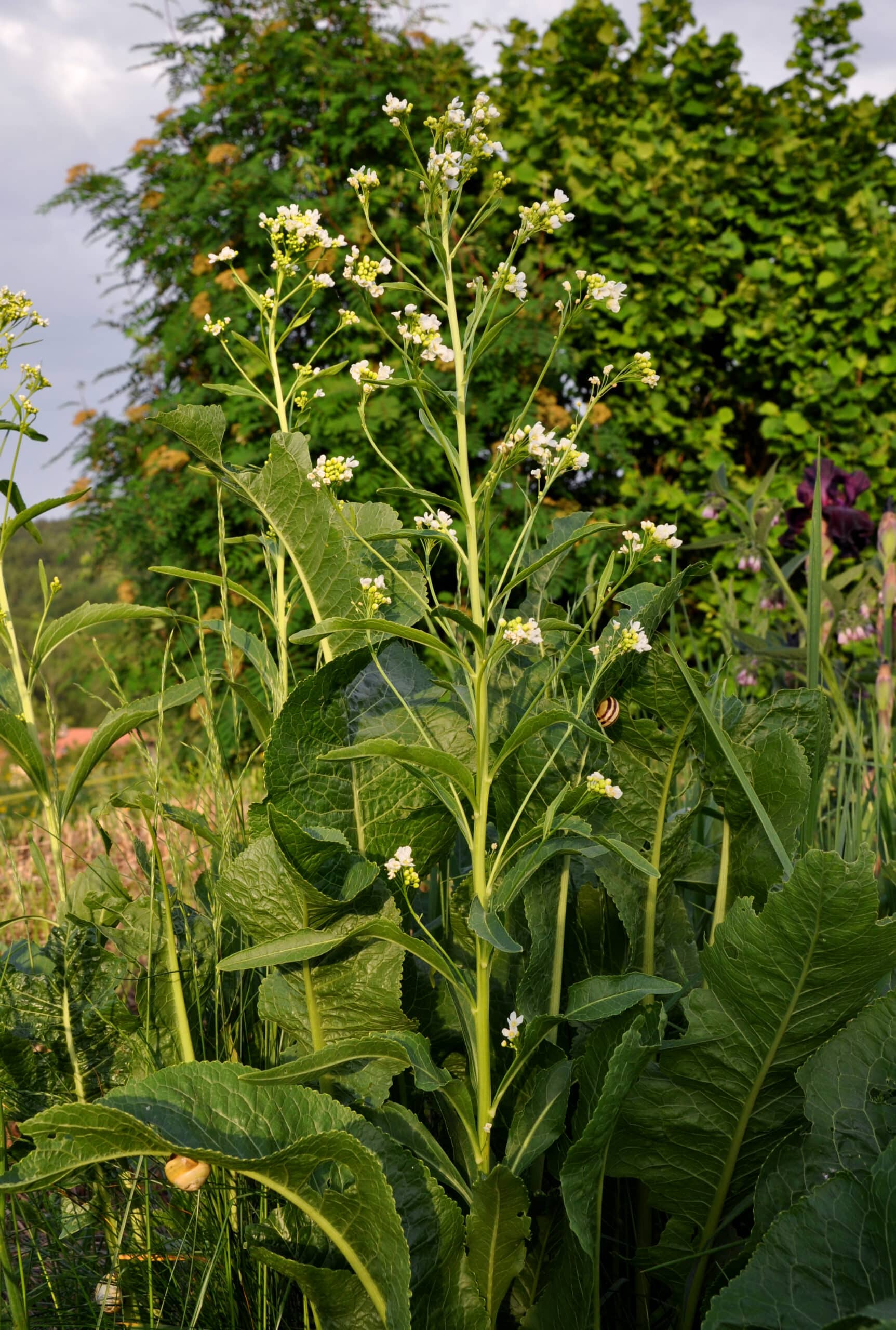
Let’s end our exploration with a plant that’s only wild when it escapes from gardens, which is not uncommon. Despite its botanical name ofArmoracia, “from Armorica”, horseradish originated on the borders of Europe and Asia, in the remote steppes of the Cossacks. The inhabitants of Germanic and Anglo-Saxon lands are particularly fond of it. In France, only in Alsace is this “strong root” seriously cultivated.[2] “.
Its large, vigorous underground stem gives rise to green tufts of enormous leaves. It’s rare to see its tiny white flowers, as horseradish almost never flowers in our regions. In fact, you don’t need to count the petals to know what kind of plant horseradish is: its violent, pungent flavour is indicative of a cruciferous plant, even stronger than mustard.
As soon as you cut it, the terrible, swollen, contoured root, light brown on the outside and white on the inside, stings your eyes and nose horribly. The corrosive effect is even worse if you grate it – be careful! Like mustard, it contains a substance that releases an essence rich in allyl sulfide when the plant is crushed.
Horseradish root is a remarkable condiment for spicing up bland dishes. In Central Europe, horseradish sauce is often served with boiled meat, stews and vegetables. In Austria,Apfelkren[3]a mixture of grated apple and horseradish, is the national seasoning. When cooked, horseradish loses its potency as its vesicant essence evaporates. In Alsace, the root is cut into small pieces, cooked in cream and then blended. Enthusiasts add a little raw horseradish after cooking to give the sauce more bite. Fresh root can be preserved in vinegar.
The young leaves have a cabbage-like flavor. Add them raw to salads. Later, they become tough and bitter, but can be cooked as a vegetable or in soup.
In moderate doses, horseradish stimulates digestion, but in excessive quantities, it becomes irritating and rubefacient. So in everything, it’s important to find the right balance…
| Apfelkren – Carefully wash and brush a fresh horseradish root. Grate it on a fine grater, taking care not to get it too close to your face to avoid eye irritation. – Peel one or two tart apples and grate them as well. – Mix the horseradish and apples, add plain yoghurt and salt lightly. This tasty Austrian condiment enhances appetizers and cereals, potatoes and boiled beef, for example in the popular Viennese specialty ” Tafelspitz mit Apfelkren “. |

[1] Harvesting palm hearts kills the tree.
[2] From Old French raïz fors.
[3] Apfel stands for apple and Kren for horseradish.

